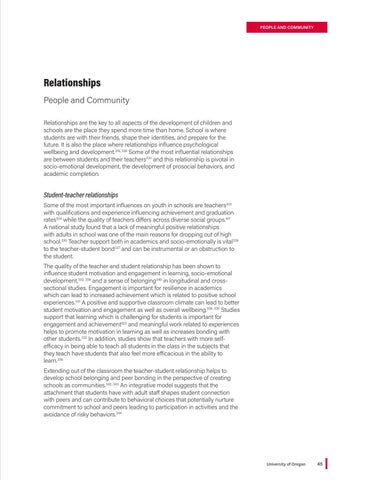PEOPLE AND COMMUNITY
Relationships People and Community Relationships are the key to all aspects of the development of children and schools are the place they spend more time than home. School is where students are with their friends, shape their identities, and prepare for the future. It is also the place where relationships influence psychological wellbeing and development.319, 339 Some of the most influential relationships are between students and their teachers332 and this relationship is pivotal in socio-emotional development, the development of prosocial behaviors, and academic completion.
Student-teacher relationships Some of the most important influences on youth in schools are teachers333 with qualifications and experience influencing achievement and graduation rates334 while the quality of teachers differs across diverse social groups.417 A national study found that a lack of meaningful positive relationships with adults in school was one of the main reasons for dropping out of high school.335 Teacher support both in academics and socio-emotionally is vital336 to the teacher-student bond337 and can be instrumental or an obstruction to the student. The quality of the teacher and student relationship has been shown to influence student motivation and engagement in learning, socio-emotional development,332, 338 and a sense of belonging340 in longitudinal and crosssectional studies. Engagement is important for resilience in academics which can lead to increased achievement which is related to positive school experiences.341 A positive and supportive classroom climate can lead to better student motivation and engagement as well as overall wellbeing.338, 339 Studies support that learning which is challenging for students is important for engagement and achievement323 and meaningful work related to experiences helps to promote motivation in learning as well as increases bonding with other students.332 In addition, studies show that teachers with more selfefficacy in being able to teach all students in the class in the subjects that they teach have students that also feel more efficacious in the ability to learn.338 Extending out of the classroom the teacher-student relationship helps to develop school belonging and peer bonding in the perspective of creating schools as communities.342, 343 An integrative model suggests that the attachment that students have with adult staff shapes student connection with peers and can contribute to behavioral choices that potentially nurture commitment to school and peers leading to participation in activities and the avoidance of risky behaviors.344
University of Oregon
45














